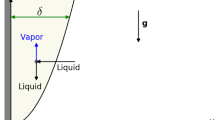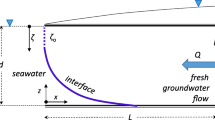Abstract
Numerical modeling and dimensional analysis is used to study the salinization of thick, high-permeability aquifers by free convection from a salt source at the surface. Current understanding of this process mainly concerns the initial stages of salinization only (boundary-layer development, break-up into fingers and initial phase of finger descent). In the modeling, special attention is paid to the role of two processes in the long-term salinization rate: (1) the progressive loss of salt from fingers by lateral diffusion, and (2) the coalescence of fingers during their descent. From the numerical simulations a relationship is derived that describes the development of the horizontally averaged salinity with depth and time as a function of permeability and initial-density contrast for aquifer Rayleigh numbers up to Ra =6,000. This relationship is consistent with and provides an extension to previous generalized relationships of the rate of finger descent. Its applicability to real-world aquifers (Ra >105) that include complexities due to anisotropy, heterogeneity, and mechanical dispersion is discussed. Application to the Pleistocene coastal aquifer of the Netherlands (thickness ≈200 m, permeability ≈10-11 m2) suggests that salinization of the aquifer during historic episodes of inundation by seawater occurred within decades.
Résumé
Une modélisation numérique et une analyse dimensionnelle ont été mises en oeuvre pour étudier la salinisation d'aquifères épais et à forte perméabilité par convection libre d'une source de sel en surface. La compréhension habituelle de ce processus concerne principalement les étapes initiales de la salinisation seule (développement d'une couche limite, partition en digitations et phase initiale de développement des digitation). Dans la modélisation, une attention particulière a été portée au rôle de deux processus du taux de salinisation à long terme: (1) la perte progressive de sel dans les digitations par diffusion latérale et (2) la coalescence des digitations au cours de leur développement. À partir de simulations numériques, une relation a été obtenue qui permet de décrire l'extension de la salinité horizontalement en profondeur et au cours du temps en fonction de la perméabilité et du contraste initial de densité pour des nombres de Rayleigh de l'aquifère jusqu'à Ra =6,000. Cette relation est compatible avec ces résultats et fournit une extension des relations précédemment généralisées du taux de développement des digitations. On discute son applicabilité à des aquifères réels (Ra >105) incluant des complexités liées à l'anisotropie, l'hétérogénéité et la dispersion mécanique. L'application à l'aquifère côtier du Pléistocène des Pays-Bas (épaisseur environ 200 m, perméabilité environ10–11 m2) laisse penser que la salinisation de cet aquifère au cours d'épisodes historiques d'inondation par la mer s'est produit durant des décennies.
Resumen
Se utiliza modelos numéricos y un análisis dimensional para estudiar la salinización de acuíferos potentes de alta permeabilidad por convección libre a partir de una fuente salina superficial. El conocimiento acutal de este proceso se limita a las fases iniciales de la salinización (desarrollo de la capa de contorno, creación de digitaciones y fase inicial de la progresión de éstas). En la modelación, se presta atención especial al papel desempeñado por dos procesos de salinización a largo plazo: (1) la pérdida progresiva de sal por difusión lateral desde las digitaciones, y (2) la coalescencia de las digitaciones durante su avance. A partir de las simulaciones numéricas, se obtiene una relación que describe el desarrollo de la salinidad con la profundidad y el tiempo, promediada horizontalmente, el cual depende de la permeabilidad y del contraste inicial de densidad para números de Rayleigh inferiores a 6.000. Esta relación es coherente con índices previos generalizados del avance de las digitaciones, y representa una extensión a estos. Se discute su aplicabilidad a acuíferos reales (con números de Rayleigh superiores a 105), que tienen complejidades asociadas a la anisotropía, la heterogeneidad y la dispersión mecánica. La aplicación al acuífero costero Pleistoceno de los Países Bajos (20 m de potencia y 10-11 m2 de permeabilidad) sugiere que la salinización tuvo lugar en décadas, debido a episodios históricos de inundación por aguas marinas.







Similar content being viewed by others
References
Ackerer P, Younes A, Oswald SE, Kinzelbach W (2000) On modeling of density driven flow. In: Stauffer F, Kinzelbach W, Kovar K and Hoehn E (eds) Calibration and reliability in groundwater modeling. Proceedings of the ModelCARE 99 Conference held at Zurich, Switzerland, September 1999. Int Assoc Hydrol Soc Publ 265:377–384
Bachmat Y, Elrick DE (1970) Hydrodynamic instability of miscible fluids in a vertical porous column. Water Resour Res 6:156–171
De Vries JJ (1981) Fresh and salt groundwater in the Dutch coastal area in relation to geomorphological evolution. Quaternary geology: a farewell to A.J. Wiggers. Geologie en Mijnbouw, pp 363–368
Dufour FC (1998) Grondwater in Nederland [Groundwater in the Netherlands]. Netherlands Institute of Applied Geoscience TNO, Delft
Elder JW (1967) Transient convection in a porous medium. J Fluid Mech 27:906–923
Elder JW (1968) The unstable thermal interface. J Fluid Mech 32:69–96
Gebhart B, Jaluria Y, Mahajan RL, Sammakia B (1988) Buoyancy-induced flows and transport. Hemisphere Publishing Corporation, Washington DC, USA
Gieske JMJ (1991) De oorsprong van het brakke grondwater in het IJsselmeergebied: diffusie, dispersie, of dichtheidsstroming? [The origin of the brackish groundwater in the IJsselmeer area: diffusion, dispersion or density driven flow?]. H2O 24:189–193
Groen J, Velstra J, Meesters AGCA (2000) Salinization processes in paleowaters in coastal sediments of Suriname: evidence from d37Cl analysis and diffusion modeling. J Hydrol 234:1–20
Koch M (1994) The dynamics of density driven finger instabilities in stochastically heterogeneous porous media. In: Peters A, Wittum G, Herrling B, Meissner U, Brebbia CA, Gray WG, Pinder GF (eds) Computational methods in water resources, vol X. Kluwer Academic Publishers, Dordrecht, pp 481–488
Kolditz O, Ratke R, Diersch H-J, Zielke W (1998) Coupled groundwater flow and transport: 1. verification of variable density flow and transport models. Adv Water Resour 21:27–46
Kooi H, Groen J, Leijnse A (2000) Modes of seawater intrusion during transgressions. Water Resour Res 36:3581–3589
Leijnse A (1992) Three-dimensional modeling of coupled flow and transport in porous media. PhD Notre Dame University, Notre Dame, USA
Meinardi CR (1991) The origin of brackish groundwater in the lower parts of The Netherlands. In: De Breuck W (ed) Hydrogeology of salt water intrusion: a selection of SWIM papers. Verlag Heinz Heise Int Contrib Hydrogeol 11:271–290
Oswald SE, Kinzelbach W (2000) A three-dimensional physical model for verification of variable-density flow codes. In: Stauffer F, Kinzelbach W, Kovar K, Hoehn E (eds) Calibration and reliability in groundwater modeling. Proceedings of the ModelCARE 99 Conference held at Zurich, Switzerland, September 1999. Int Assoc Hydrol Soc 265:399–404
Post VEA, Hooijboer AEJ, Groen J, Gieske JMJ, Kooi H (2000) Pore water chemistry of clay layers in the southern North Sea: clues to the hydrogeological evolution of coastal areas. In: Sadurski A (ed) Proceedings of the 16th Salt Water Intrusion Meeting, Miedzyzdroje, Wolin Island (Poland), 12–15 June 2000, pp 127–132
Sauter FJ, Leijnse A, Beusen AHW (1993) Metropol's user guide. National Institute of Public Health and Environmental Protection (RIVM). Bilthoven, The Netherlands
Schincariol RA, Schwartz FW (1990) An experimental investigation of variable density flow and mixing in homogeneous and heterogeneous media. Water Resour Res 26:2317–2329
Schincariol RA, Schwartz FW, Mendoza CA (1994) On the generation of instabilities in variable density flow. Water Resour Res 30:913–927
Schincariol RA, Schwarz FW, Mendoza CA (1997) Instabilities in variable density flows: stability and sensitivity analyses for homogeneous and heterogeneous media. Water Resour Res 33:31–41
Simmons CT, Narayan KA (1997) Mixed convection processes below a saline disposal basin. J Hydrol 194:263–285
Simmons CT, Narayan KA, Wooding RA (1999) On a test case for density-dependent groundwater flow and solute transport models: the salt lake problem. Water Resour Res 35:3607–3620
Stuyfzand PJ (1993) Hydrochemistry and hydrology of the coastal dune area of the western Netherlands. PhD Vrije Universiteit, Amsterdam
Volker A (1961) Source of brackish ground water in Pleistocene formations beneath the Dutch polderland. Econ Geol 56:1045–1057
Volker A, Van der Molen WH (1991) The influence of groundwater currents on diffusion processes in a lake bottom: an old report reviewed. J Hydrol 126:159–169
Voss CI, Souza WR (1987) Variable density flow and solute transport simulation of regional aquifers containing a narrow freshwater–saltwater transition zone. Water Resour Res 23:1851–1866
Wooding RA (1962) The stability of an interface between miscible fluids in a porous medium. Zeitschr Angew Math Phys 13:255–266
Wooding RA (1969) Growth of fingers at an unstable diffusing interface in a porous medium or Hele–Shaw cell. J Fluid Mech 39:477–495
Wooding RA, Tyler SW, White I (1997a) Convection in groundwater below an evaporating salt lake: 1. onset of instability. Water Resour Res 33:1199–1217
Wooding RA, Tyler SW, White I, Anderson PA (1997b) Convection in groundwater below an evaporating salt lake: 2. evolution of fingers or plumes. Water Resour Res 33:1219–1228
Acknowledgements
This project is funded by the Netherlands Institute of Applied Geoscience TNO. SARA (Academic Computing Services Amsterdam) is acknowledged for their permission to use their IBM SP2 for the numerical calculations. We would also like to thank Toon Leijnse for his constructive comments, Lester Reiniers of the province of Noord-Holland for the chloride data, Prof. Meijer and Dr Van der Plicht of the Centre for Isotope Research in Groningen for the 14C measurements and Victor Bense and Elmer van den Berg for their reading of the manuscript.
Author information
Authors and Affiliations
Corresponding author
Rights and permissions
About this article
Cite this article
Post, V.E.A., Kooi, H. Rates of salinization by free convection in high-permeability sediments: insights from numerical modeling and application to the Dutch coastal area. Hydrogeology Journal 11, 549–559 (2003). https://doi.org/10.1007/s10040-003-0271-7
Received:
Accepted:
Published:
Issue Date:
DOI: https://doi.org/10.1007/s10040-003-0271-7




